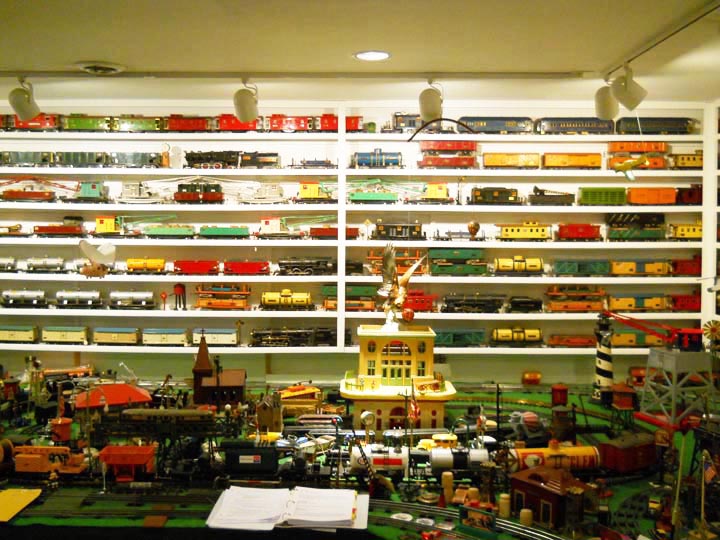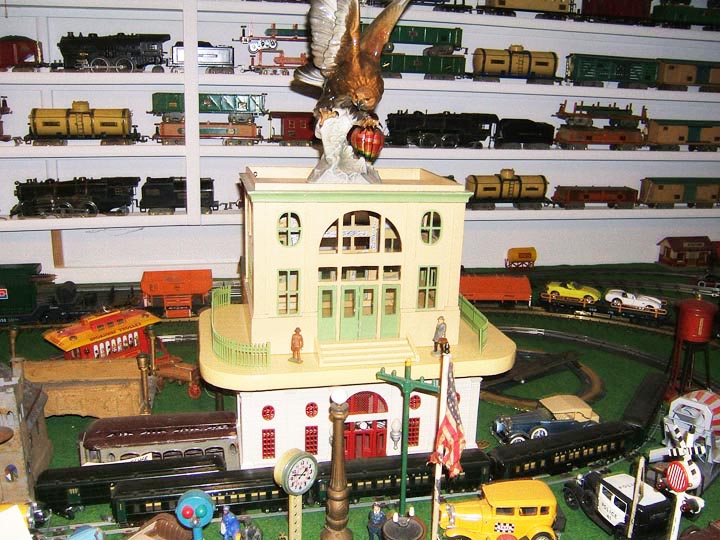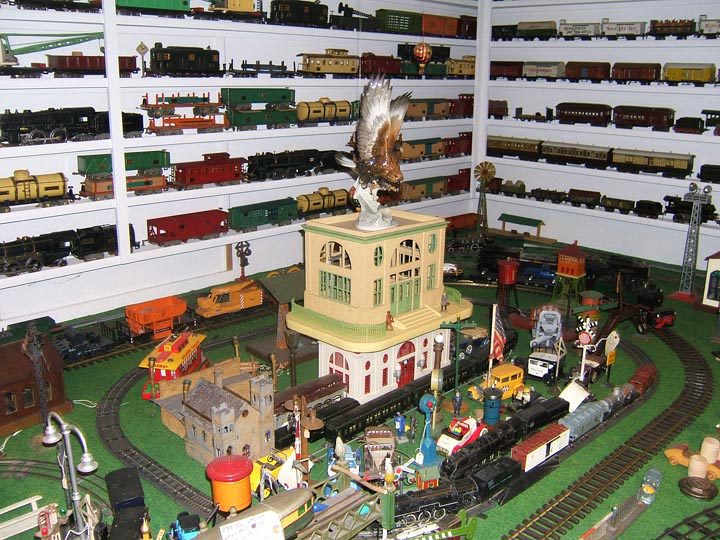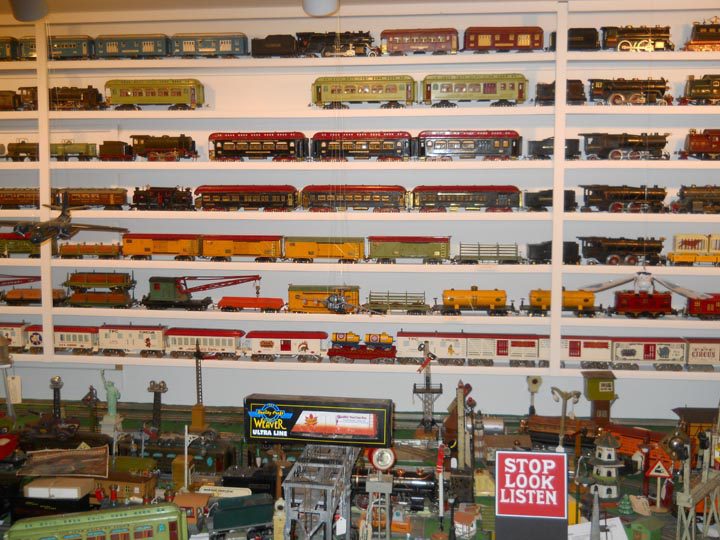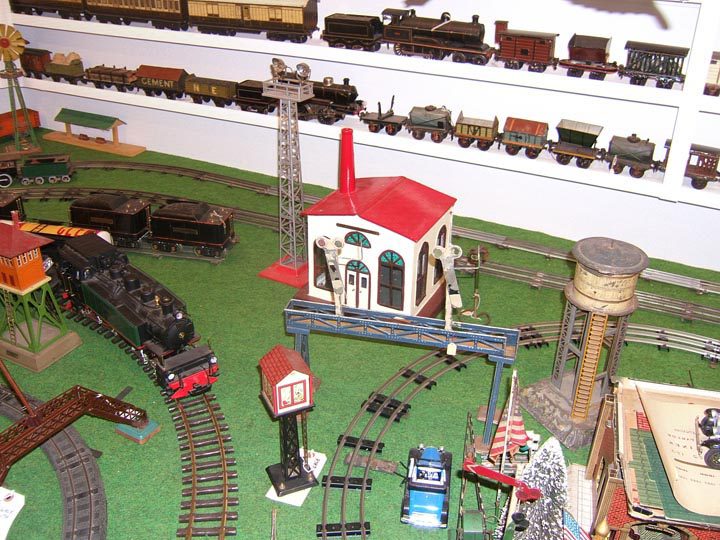White Paper on the Future of Collecting Trains (A look forward from 2003)
By Clem Clement TCA 64-987
(Written in June 2003; published Winter 2013)
Author’s Addendum: Please note I wrote this ten long years ago. Lots have happened and sadly several TCAers have passed on. Your comments/additions are most welcome.
One area I see growing are cross hobby events. 24 years ago I started a multi-gauge train and old car show at the reconstructed Fairfax Station. We continue to have great success with train folks working different gauges talking to each other and to the old car people. Many antique car folks have trains as well. Locally we started a breakfast series with train and car people and spouses enjoying fellowship over eggs. No agenda, just shared conversation with friends.
Actually this February we will host the 41st Trains and old car day at Clem’s. It is a thrill to see car people talking to trains people. Both hobbies struggle with the graying of its members, recruiting new members, finances and collectable issues.
Gone are the $50 Blue Comet sets.
Gone are the choices between 6 boxed 4U sets at one meet.
Gone is the mega surprise of the first-found nickeled 216 hopper.
Gone are the stacks of boxed Flyer sets on meet tables.
What we have is an exciting new era of training and let’s jump in it and enjoy it!
This is a collection of thoughts that have been rattling around in my head. I have captured them here on paper, but have not tried to organize or polish them. As I re-read much of this, it sounds like I think all is hopeless and that is not so- we have a great hobby that is very healthy.
Why bother with this entire struggle and fight over change. Hey, change is already surrounded us and it is wonderful. We have success and we don’t know it. Before we wanted more folks to get into trains and we have one of the few growing hobbies. We, as kids wanted different choices for trains, and we have it-several excellent manufacturer’s building choices for us. We fretted over trains that wouldn’t run due to metal fatigue, warping or parts wearing out and we have repro parts for nearly everything and repair folk galore. We have always wanted to run trains and couldn’t because of money, space or situations- we now have running clubs, model and scenery interests and repair groups. We have it all.
Let’s plan for the glory days of the 2010’s and 2020’s and not pine for the return of the also exciting 1960’s-1990’s. One of our sister hobbies (AACA-Antique Automobile Club of America) is looking for a new national director. They desire him/her to take the hobby back the glory days of the 60’s. Technical articles about repair, excitement about new finds, etc. Not the thrusts toward the new focus’ of hobbies- family participation, functioning equipment and group happiness. History needs to teach what we had so we can enjoy what we now have and where we are going next. Psalm 71 talks about even thou we have gray hair, we must teach what is before us, not what we have had in the past. The past is prologue.
Years ago I was bringing a neophyte along into the hobby and he saw my walls of trains and trains available for swapping and he asked if they ran. I said very few and that most of the customers didn’t care it they ran or not. They wanted the piece for their collection and shelf. Age deterioration; warping; space; use of replacement parts; etc., etc. precluded the equipment from running. Condition of the surface; completeness; color; and part variations were the key to having a desirable piece and still are for many of us. The requirement to come down off the shelf and rumble along the track is back, however, and that ain’t bad. I ran an IVES 3237 loco on the floor at a local meet recently and it stunned some to see her rolling again. Sometime back I had an IVES 1125 steamer and set it on the mainline. Several visitors commented and asked “wasn’t I afraid to run the set?” Not at all.
Should we change our name to TCOA? (Train Collectors and Operators Association). I don’t think so, as the politics of a name change often blurs the objective and is blinded by a fight for tradition, so that its purpose is to destroy. Let’s grow into the society that collects and operates toy trains. Maybe mergers with the scale thinkers, but I’m not sure. Maybe mergers with the Garden railway thinkers, but probably not, as weather is too hard on paints and electronics. But helping each other’s Clubs is not too hard nor is it a bad thing.
I started a multi-gauge “Model Trains at Fairfax Station, VA Show” 14 years ago. The concept is to have running trains of all the major gauges in one place. We have loco doctors, food, Kids Korner and lots of memorabilia from the Civil war. The Station has been reconstructed and located near its original site by the tracks. Clara Barton worked her magic there on soldiers of both the Blue and Gray, we are steeped in history and it fits perfectly with the running trains. A local Garden Railways club runs trains completely around the outside of the station as there is no more room inside. Last year it snowed, and they were killer-popular to the over 1000 visitors with their snow blowers throwing real snow! Santa, a TCAer of course, was there to give out joy. My happy apex point is that the clubs of different gauges are getting to know each other and share techniques and in some cases, members. And yes, friends, I cry there, as well as, at York. We had a little boy bring his dead loco to the loco doctors’ table-“can you fix my engine he pleaded?” His eyes told the story. Dan Danielson worked on it and found the problem. It jumped to life on the test track and the little boy’s eyes shone, as did, his parents’. Dan took him out to the “real” track and ran his engine big time.
Something got in my eye during that time- dunno what. TCA member Bob Tufts noticed a boy watching the S gauge trains run on Bob’s custom built layout in the dispatcher window at the station. He did not smile nor want to run the trains. He stayed a long time. Finally, with Bob’s huge people skills at work, he showed some emotion. With tons of encouragement, the little boy made the barrel man load barrels into the waiting gondola so the duty freight could deliver the goods down the line. This boy had lost his dad six months previously and the barrelman was his coming out. Not all bad.
Walking the hallowed halls of York and studying the tables is an interesting game. You can pass 20 tables before some prewar standard gauge appears. And good+ condition material is harder to find. If your memory is good, you can recognize pieces year after year on a table still marked at silly high prices. The predominance is the plethora of modern trains now available. This is wonderful. But if that is the product out there, does our board and leadership structure contain members who are experts in this area and actively function this area? I, for one, find I can’t discuss or think in the modern terms. I attended a National Capital Trackers (O gauge modular Club) meeting the other night and they were doing a track cutting seminar. I was overwhelmed with the tools and the ease of the job. These guys were good. But who is on our boards? If we don’t change to include our modern train thinkers, they will go somewhere else or get discouraged. Let’s do something now.
Attics are not completely empty, but the finds are sure few and far between. I used to do local auctions several times a month with good results. Yard sales have been cold for years.
Face it; our primary sources for prewar trains are eBay or the major auction houses. So we block eBay from attending and we damn auction houses in our rules. We are our worst enemy. We seem to be against the auction houses because in our way back past, senior members abused the auction name. Not schooled certified auctioneers, except a very few, but members themselves who did auction-like events to the detriment of the trains’ owners. Why not change these rules and let them advertise in the directory and at meets? Lou Redman’s trains are coming up for auction and we can’t advertise that on a meet floor. Say what?
I am stunned at the number of folks playing with trains that know of TCA and refuse to join. Before we chase newbies, why not change the minds of those who already are known as train collectors. Stouts Auction’s following only contains 20% TCA members. Hundreds come to the bandit shows and leave Thursday evening. VTC and the Baltimore S gauge clubs contain 40% non-members. Whatta we thinking? These men and women love trains and not us. Why not find out why and fix us???
At the last York, I put out TCA applications in the Holidrome Hotel lobby. I don’t know if I am allowed to do that or not, but did it anyway. 30 were gone in 30 minutes. What does that say?? I have been to many a meet where I could not find an application to TCA. We may be our own worst enemy.
Why not join?
Too many rules
The promise not to fake trains
Can find/do trains at public shows just as well.
Never been rushed to join.
Let’s go young and grow. Our senior guys built this great club not knowing what or how it would turn out. Now many ask me to steer us back to a quieter time- the 60’s. (It wasn’t quiet to me I was in Vietnam twice. I don’t wanna go back). I wanna grow us into something new as well as keep the something we can count on- the excitement, so that I can look at back to the 2020’s and say that was really the heyday of TCA. And I dunno what that will look like…
I have a note from a senior member that I am “wrasslin” with at the moment to answer. He wants to limit membership and not go after any more members. He suggests we match our decline to the actuary tables with. And reduce fees…
Prices are silly high. This will probably continue, but it eliminates newbie’s from running trains and from building a large collection. Plus now the Greenberg books are everywhere. So instead of having 75 versions of IVES freights, they have our books. What is the drive to collect? Have the photo and the write-up. If they have a piece or two, that covers it. Plus those interested in the difference between the 1923 and 1924 versions of some freight car are shrinking in numbers. I’m getting where I can’t remember as well. I have the famous IVES wall which displays IVES freights from 1921 to 1927 row above row. So at a glance, you can see the difference between the 1923 production run and the 1924 run. Visitors are mildly interested, but not in the numbers as before.
I visited a fellow trainer’s home recently. I was stunned at his back store room. Boxes of slightly used modern trains waiting for the layout to be finished or time to jump on him. Thousands are like him. Are we serving him in TCA-I don’t think so?
Greed is an all-blinding trait in humans. Our rules smell of the insiders setting rules to keep the outsiders out. Blocking info, not sponsoring price guides, not helping widows with their husband’s trains. Not being there for the small collector. Not helping the newbie- just wanting to stick him with junk trains- how many times have I heard that?? A newbie came to my table years ago and wanted to buy a Lionel 42 I had. He said he wanted to run it for Christmas. I refused to sell it to him as this particular one had a thoroughly worn out motor. He “fussed”, but came back years to thank me. Done often?
How many Blue comets sets were at the last York?
How many State sets?
How many 4U boxed?
How many Rail Chiefs?
Postwar trophies?
Much of the big stuff doesn’t cross the York table any more. It is out there and changes hands, but privately, thru eBay or via auction. What do folks come to York for? The fun of it. My son was looking for sponsorship for his college rugby trip to South Africa. What he said made me so proud of TCA: he said “of the adult friends of yours I know, most are TCAers.” More tears.
Remember, these trains are not being played with to their destruction or tossed out or lost. They are out there, just not in circulation. In the old days an active collector added to the available mass of train opportunities. Here’s how it went. Members/dealers worked the local yard sales, newspapers, auctions, friends, bulletin boards, etc., and found trains. These sets, pieces, junk flowed to the next meets or were sold privately to other dealers.
At the meets they moved into collectors hands. Some stopped there and stayed in that collectors’ collection. If the collector had that piece in lesser quality or more common color or style, the collector’s piece came out for sale. Next meet that piece flowed along again to another owner. In some cases the pieces improved as they moved around. The first or second dealer probably cleaned the piece and straightened bent metal. Someone added parts that were needed. Repro parts might be added. If the piece was junk, it may get a repaint along the way. If it went on a layout, it was run with cars and not destroyed.
Ultimately the piece would come out again as the collector down-sized his collection. So the flow was positive and continuing. Now with eBay and the huge number of collectors, the flow is outgoing. Attics and basements are nearly empty of finds and unknown collections. They are still out there, but the major portion has been discovered.
Sadly, sadly, I have a large collection of trains that should not have left the family’s home. Grandpa’s train went to junior and he put it on the shelf and admired it and remembered his Dad thru it. Grandson may have never seen it run, has no money and sells it without feeling (I tuned up a set that a daughter had never seen run- she was 70+ and cried like a baby when Dad’s Lionel #33 roared off). Kids don’t see real trains carrying Dad to work or themselves into town and they don’t identify with Grandpa’s old set that they can’t touch. They want today’s hi tech stuff that functions and is safe to touch. Locally, we have the Virginia Railway Express established a few years back for commuter traffic. At the recent Manassas Train Days celebration, every fun run was packed with families out for a Saturday joy ride on the train. The potential is there. The same thing has occurred with the Model T Ford. It has been relegated to “that old shiny thing in the back of Grampa’s garage.”
eBay has scattered trains all over the globe. Before, trains were centralized in the Northeast, Chicago area and generally in cold “climes”. The kids came in during the winter and played indoors. Also trains were manufactured and distributed in the bigger cities. Below Richmond, VA (a surprising hot bed of postwar trains, by the way), and west and south trains were much less popular. Florida and other retirement areas had trains as that is where Grandpa retired. The next generation of collectors will be making surprising finds everywhere, not just in the East.
For many years when I was actively buying, repairing, upgrading and trading trains, I was helping the flow of trains. For example, I attended auctions about 5 times a month in the New England area. Items found were taken home. All my trains were cleaned and straightened before offering them on a meet table. Junk was either repainted or kept as parts pieces for the next find. Repro parts were added if necessary and the improved piece returned to circulation. In my chase of IVES standard gauge freights (I have 75 different versions) I must have handled 500. Each was cleaned, improved, identified and either kept or re-circulated. No dupes were kept. As an aside this led me to be able to contribute heavily to the Greenberg book series. My Ives Tiger set went thru 15 cars before I found a matching set of three. The others were improved and sent down the rails.
Run ‘em if you got ‘em and/or collect ‘em if you want ‘em and change with the times or fade with the sun.
Clem Clement

